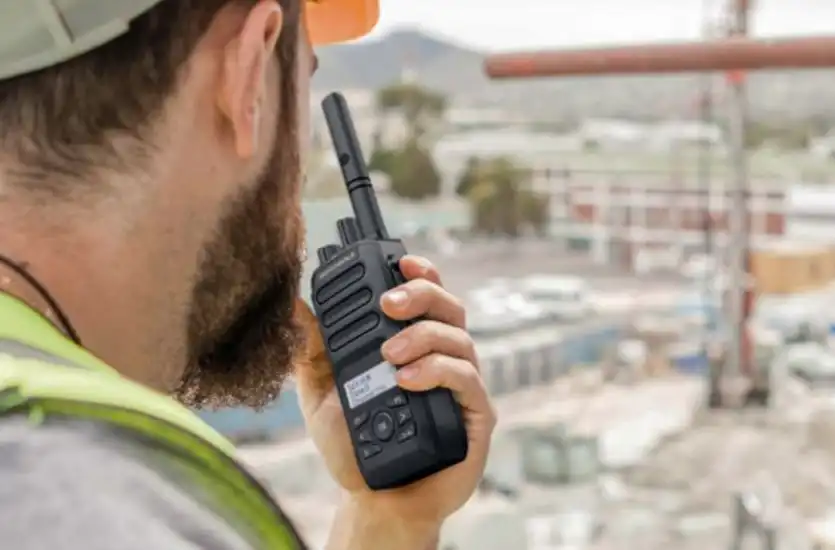In high-stakes environments where seconds matter, clear communication can mean the difference between order and chaos. Land mobile radio (LMR) systems have long served as a lifeline for professionals in public safety, utilities, transportation, and commercial sectors. Today, these systems continue to be the communication backbone for teams that require secure, instant, and reliable connectivity in every situation.
Whether a firefighter coordinates rescue efforts, a utility worker restores power after a storm, or a transportation crew manages logistics across a rail line, LMR technology ensures the message gets through every time.
In this article, we’ll explore the key features and benefits of LMR technology, as well as its applications in various industries.
What Is an LMR System?
An LMR system is a professional two-way radio communication network built for groups that need dependable, real-time voice communication. Unlike consumer-grade walkie-talkies or mobile apps, LMR systems are designed for mission-critical settings where downtime is not an option.
Operating on designated radio frequency bands such as Very High Frequency (VHF), Ultra High frequency (UHF), and 700/800 megahertz (MHz), these systems include infrastructure, like base stations and repeaters, to extend the range and maintain coverage. Encryption and signal priority capabilities make LMR networks secure and interference-resistant, providing a level of dependability that consumer and commercial cellular systems can’t match.
Key Components of an LMR System
A complete LMR network includes several key pieces of equipment that work together to provide seamless communication. Base stations act as central communication hubs, while repeaters amplify signals to ensure coverage across large areas or difficult terrain. Portable and mobile radios, often rugged and water-resistant, allow users to stay connected in the field.
The choice of frequency band plays a major role in performance. VHF is ideal for rural and open areas, while UHF offers better performance in urban environments with obstacles. Due to its capacity and coverage, the 700/800 MHz spectrum is often used in public safety and large-scale municipal systems.
Interoperability is another vital feature. In large-scale incidents involving multiple agencies, it’s essential that police, fire, emergency medical services (EMS), and other responders can communicate without barriers. LMR systems are often designed to allow this cross-agency coordination without the need for extra equipment or conversions.
How LMR Systems Support Critical Industries
A wide range of industries rely on LMR systems to keep operations running smoothly. Public safety agencies depend on them to coordinate efforts in emergencies. Utility companies use them for real-time communication when restoring service during outages. In transportation and logistics, LMR supports traffic control, maintenance coordination, and employee safety.
The common thread is the need for immediate, secure, and always-on communication. Many industries are subject to regulatory guidelines that require the use of reliable radio systems. These requirements often stem from safety protocols or operational mandates tied to occupational risk.
Public Safety and Emergency Response
First responders rely on two-way radios in emergency response and disaster management to stay connected when every moment counts. Police officers use LMR systems to coordinate field operations, dispatch resources, and stay in touch during pursuits or incidents. Meanwhile, fire departments depend on radio systems to relay tactical updates, alert crews to changing conditions, and execute rescue missions with speed and precision.
EMS personnel also use portable two-way radios to communicate with hospitals and coordinate with other emergency services. Products like MOTOTRBO portable radios are specifically built for these high-demand roles, offering advanced encryption, noise suppression, and durability under pressure.
These systems are often the only lines of communication that remain operational during natural disasters when cellular networks become overloaded or fail completely.
Business and Industrial Applications
LMR technology is also instrumental in the construction, manufacturing, and transportation industries. Workers on a busy job site or factory floor must relay information instantly to avoid delays, minimize risks, and maintain productivity. LMR radios provide a direct line of contact between team leads, machine operators, and safety supervisors.
In retail and hospitality, these systems help staff coordinate discreetly and improve customer service. They can also support loss prevention practices by enabling quicker response to suspicious activity or shoplifting, especially in large or multi-store locations.

The Advantages of LMR Over Other Communication Methods
Compared to smartphones or internet-based systems, LMR offers unmatched dependability. Cellular networks can fail during emergencies, and internet services may lag or disconnect altogether. LMR systems, on the other hand, are designed to keep teams connected through signal prioritization, dedicated frequencies, and independent infrastructure.
Coverage is another major advantage. While mobile phones rely on commercial cell towers that can become congested, LMR networks use repeaters and base stations optimized for the locations and needs of the organizations using them. This setup allows consistent service in tunnels, basements, remote roads, and large industrial campuses.
Furthermore, with encryption capabilities built into the hardware and the transmission process, LMR systems offer private communication that cannot be intercepted easily. This level of protection is critical in law enforcement, healthcare, and industries managing sensitive data.
Reliability and Durability in Any Environment
LMR radios are engineered for field use, with designs that withstand shock, moisture, and dust. Many models boast extended battery life that lasts through double shifts without needing recharging — something smartphones often struggle with in demanding environments.
These radios have proven to be lifelines in remote areas or during hurricanes, wildfires, and power outages. Unlike apps or cellular systems that rely on the internet or shared towers, LMR networks can continue functioning even when other communication options go dark.
Digital Versus Analog LMR Systems: Which One Is Right for You?
When selecting an LMR system, it’s important to understand the distinction between analog and digital radios. Analog systems offer basic voice communication and are often simpler to operate. However, digital LMR systems provide significant advantages in voice clarity, range, and data integration.
With digital LMR, users can send text messages, Global Positioning System (GPS) locations, and other information in addition to voice. These systems support features like noise cancellation and automated call logs, making them ideal for complex, fast-paced environments.
Systems like the MOTOTRBO infrastructure support scalable communication networks with multiple channels and flexible configurations. Businesses upgrading from analog to digital often see efficiency, safety, and team coordination improvements.
Best Practices for Deploying and Maintaining an LMR System
Choosing the right LMR system begins with understanding your operational needs. Consider factors like team size, coverage area, and what environments your teams will face during operations. Once you’ve identified the appropriate hardware and frequency range, professional installation ensures that base stations, repeaters, and antennas are positioned for maximum efficiency and performance. To keep communication lines open and reliable, consider the following best practices:
- Perform routine firmware updates to keep devices current with the latest security patches and features.
- Run regular system tests to identify and address potential issues before they affect operations.
- Inspect radios and infrastructure components to ensure physical integrity and functional readiness.
- Monitor battery health and signal strength to prevent mid-shift communication breakdowns.
- Check antenna alignment and placement to maintain consistent coverage across your operation zones.
- Use encryption protocols to secure communications and prevent outside interference.
- Establish access controls to ensure only authorized users can transmit or receive messages.
- Train personnel on system use and emergency procedures to maximize efficiency during high-pressure situations.
Every organization depends on communication to keep people safe and operations on track. Investing time and resources into deploying and maintaining your LMR system helps ensure your teams stay connected when it counts the most.






